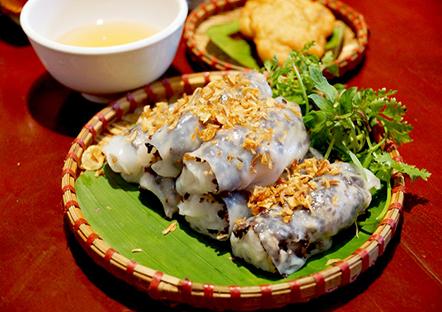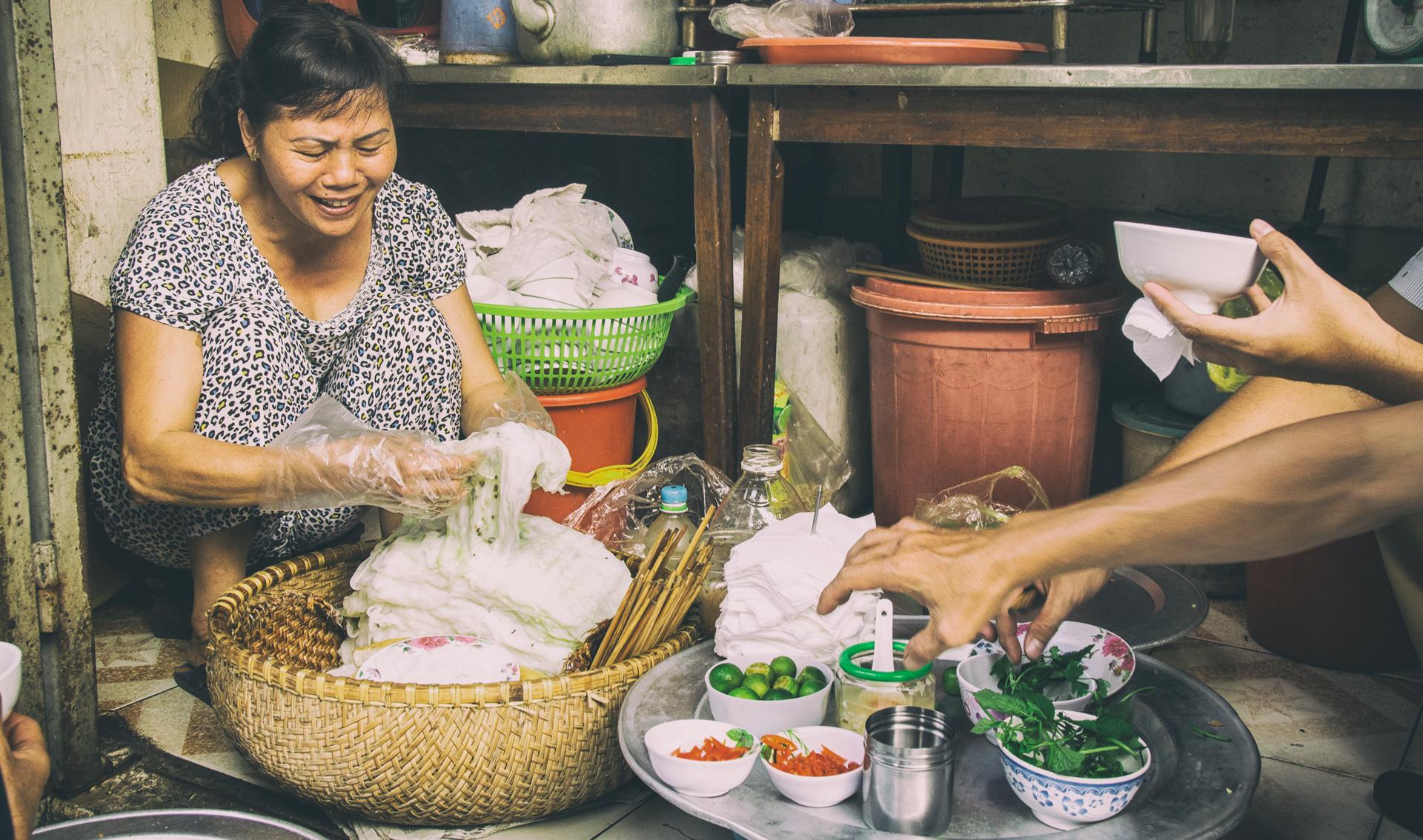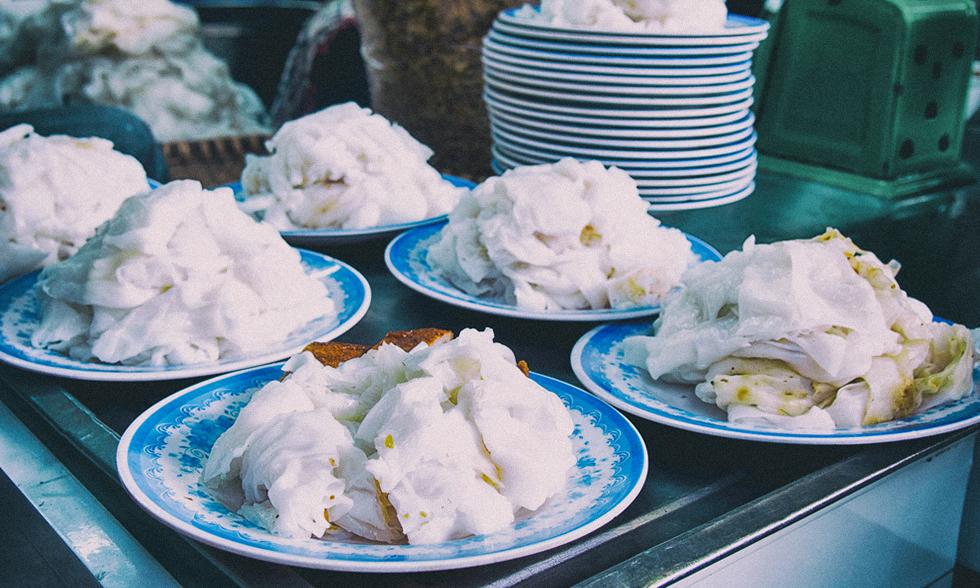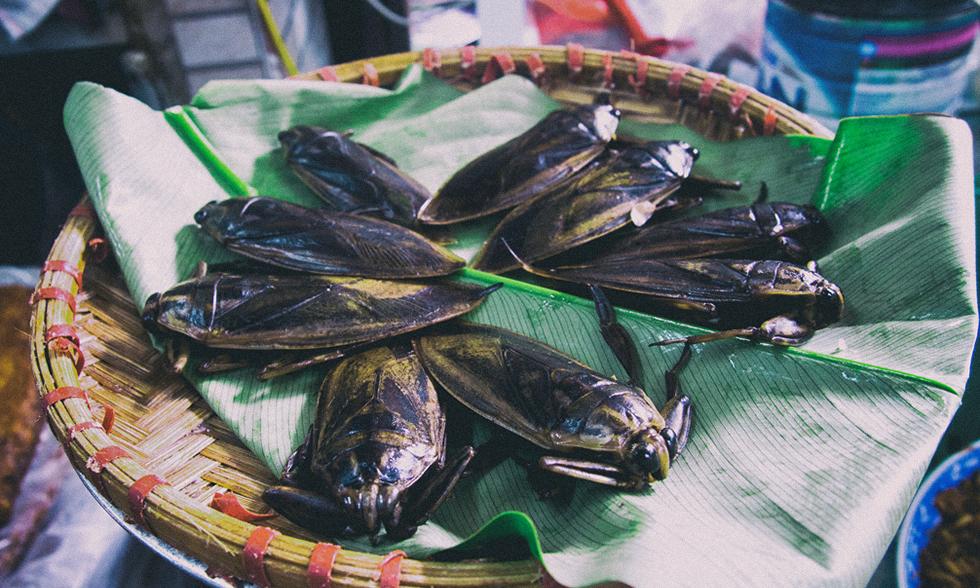The moment one sees the cook’s hands split her pile and absently roll each sheet onto a humble dish, he falls instantly in love with those soft, shiny rolls. One wants to drop his chopsticks, pick up a piece and touch it to his lips—gently, as though taking his first kiss.
From simple vegetarian snack to gymnastic meat-stuffed meal, banh cuon has come a long way.
During the 1940s, Vu Bang began his days by watching the silhouettes of women in long brown blouses flow out into the breaking dawn.
“Their merchandise consisted of next to nothing: a basket perched on their heads, covered by a bamboo screen […] a bottle of fish sauce, a jug of vinegar, a cup of chili, a few plates and around ten chopsticks,” Bang wrote in his book, Hanoi Delicacies.
Each basket contained translucent sheets of uncut rice noodles packed between emerald banana leaves—the stuff of the town’s daily banh cuon.
For generations, the dish has provided a restorative breakfast to working stiffs and intellectuals, while offering a reliable midnight belly-warmer to drunks, junkies and gamblers—Bang had one or all of these things at various points in his life.

Even when Hanoi was home to less than a half million souls, one had to stand in line for the very best banh cuon.
“Fancy diners, beware.” Vu Bang warned in a description of his favorite spot, a table and four stools. “You must be patient. It’s not possible to be served right away.”
While Bang offered a long list of variations on the dish, he favored a cold vegetarian preparation that consisted simply of “thin sheets dabbed with oily shallots.” Banh Cuon Thanh Tri took its name from the place where Bang exclusively ate them.
Like so many things, the village contours have disappeared in modern Hanoi’s urban sprawl.
During Operation Léa—the brutal French bombardment of urban revolutionary strongholds in 1947—Bang sat just a dozen kilometers outside Hanoi, staring longingly in the direction of Thanh Tri Village.

He spent his mornings hiking to surrounding markets to sample random variations on the dish, hoping they might satisfy his cravings.
They didn’t.
Outside Thanh Tri, Vu Bang found banh cuon either too thick, too greasy or (puzzlingly) “too fragrant.”
Nearly sixty years later, VnExpress International found a Thanh Tri native selling the delicacy in an alley off Nguyen Che Nghia, just south of the Old Quarter.
One can imagine Bang stepping skeptically in line behind the customers patiently waiting for their favorite cook to arrive.
Keeping Bang’s favorite alive
At 3 p.m., a few hungry punters loitered around a closed steel door slung with a bun-pho signboard.
Fifteen minutes later, Tuyet puttered up on her motorbike in flower-print pajamas and yanked the steel doors open in a single swipe.
As she began unpacking heaps her basket, each member of the queue drew a stool from a pile and formed a semi-circle around her.

Tuyet and her basket of tender, shiny rolls
Idle cruller vendors stared on, green with subtle envy, as Tuyet unpacked the tender noodles that once melted Vu Bang’s heart.
“The moment one sees the cook’s hands split her pile and absently roll each sheet onto a humble dish, he falls instantly in love with those soft, shiny rolls. One wants to drop his chopsticks, pick up a piece and touch it to his lips—gently, as though taking his first kiss.”
Today’s crowd grew just as excited, if somewhat less sentimental.
“Five big piles for my kids.”
“One more plate please.”
“Three kilos here.”
The final order cleared half of Tuyet’s inventory.
“Serve the hungry ones first,” said Nhung who regularly dined on the banh cuon Tuyet’s served going back to before 1968. “My husband can wait, but save me a kilo.”
“The moment one sees the cook’s hands split her pile and absently roll each sheet onto a humble dish, he falls instantly in love with those soft, shiny rolls. One wants to drop his chopsticks, pick up a piece and touch it to his lips—gently, as though taking his first kiss.”
Customers fidgeted on their stools. Some opted to kill time by volunteering for the cause: cutting limes, bagging fish sauce and wrapping takeaway orders for those ahead of them.
All they wanted were the noodles Bang warned “slip down the throat before they touch the lips.”


Banh cuon Thanh Tri, sometimes spiced with waterbug
A steamy competition
Just before Bang was sent down to Saigon (a mission that would consume the rest of his life) he began to notice the introduction of grilled pork belly into banh cuon—an addition he found strange.
Suddenly, his delicate rice sheets were being stuffed with chopped pork, wood-ear mushroom and, later, chicken, prawn and crumbled sausage.
Bang dismissed these stuffed rolls as “reformed banh cuon” a greasy if somewhat appealing perversion. Eventually, the warm stretched sheets won his grudging approval.
Sitting at a makeshift stall with his warm belly, Bang amusedly wondered, “Have those government officials ever had the chance to relish this dish?”
Today, banh cuon cooks compete to prepare the thinnest possible noodles capable of holding the most amount of meat. Critical customers stand at their elbow, watching them work over a cloth stretched above a pot of boiling water.
“I’ve seen others break the rice wrap,” one customer crowed to Van, owner of a 43-year-old stall on 14 Hang Ga Street. “That’s why I always end up visiting yours.”

With that, Van tossed an egg onto a sheet steaming before her and folded it up without breaking the yolk.
The 67-year-old cook says she sacrificed a healthy spine and most of her good years mastering the technique. Her most trusted apprentice spent five years watching her in action before she was actually allowed to cook for customers.
The test of time
Decades after Bang’s father brought him his first banh cuon, the writer questioned whether the food had lost its flavor or he had.
Most of his favorite cooks had died and his appetite for the dish had waned—he could no longer eat the steamed flat noodles by the basket-load.
Some banh cuon appear to have survived the ravages of time.
After two decades, regulars at 72 Hang Bo street still happily stand in the Old Quarter’s mad rush hour traffic, patiently awaiting a tiny table.
Dressed in a butcher’s apron and backward baseball cap, An, the powerful force behind Banh Cuon Quang An fills her tender rolls with chicken or pork-filled from 5-9 p.m. every day.
The secret here is a cup of rich broth.
Celebrity Chef Bobby Chinn claimed he spent eight years eating between An’s narrow orange walls lobbying for her recipe.
“You mix bone broth with fish sauce and that’s it,” she told VnExpress International with a shrug.
Between cooking and making change, An advised first-timers to add fresh lime and chili to their broth before dumping it over a plate of four slender rolls.
“Some of the five-star hotels have asked her to make it for them so they can sell them on their buffet counters,” Chinn said. “But she simply prefers die-hard fans that wait until she is free to cook for them.”

